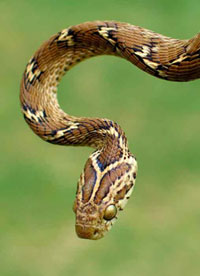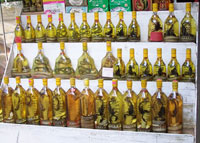 Cruising Hong Kong’s street markets is a savvy shopper’s dream come true. Fashion hounds can score bagsful of famous label clothing copies, counterfeit leather accessories, faux pearl necklaces, and fake jade gewgaws. Gadget buyers gravitate to stalls overflowing with cameras, watches, and electronic gizmos. On a recent ramble through a bustling night bazaar, none of the above were on my list. I was seeking a somewhat more authentic trinket. Snakes.
Cruising Hong Kong’s street markets is a savvy shopper’s dream come true. Fashion hounds can score bagsful of famous label clothing copies, counterfeit leather accessories, faux pearl necklaces, and fake jade gewgaws. Gadget buyers gravitate to stalls overflowing with cameras, watches, and electronic gizmos. On a recent ramble through a bustling night bazaar, none of the above were on my list. I was seeking a somewhat more authentic trinket. Snakes.
Some cultures regard serpents with fear and loathing. Not the Chinese. A person born in the Year of the Snake is considered wise and cunning. Able to slip in and out of tight situations with ease. A formidable foe and a staunch ally. Cool, calm and collected. Strikingly beautiful. Exotic. Sensuous. If one is not fortunate enough to be born in the lucky year, there’s an alternative way to pick up a little snake essence. You can eat them.
Since snakes are cold-blooded creatures, the Chinese believe that consuming snake meat acts as a heating agent for the human body and protects it from becoming chilled during the winter. Restaurants serving serpent suppers begin advertising their seasonal specialties as soon as the cool winds of autumn begin to blow. The classic recipe for snake soup uses three to five types of snake meat, as well as water chestnuts, sugarcane, bamboo shoots, and fish maw. Bowls of clear delicately flavored snake broth come to the table garnished with chrysanthemum petals and lemon leaves.
 Fried snake, which has a taste and texture similar to eel, is offset by the pungent flavor of ginger, garlic and green onions. Fried snake liver with soya bean sauce and deep-fried snake skin are other favorite delicacies. The ultimate reptilian repasts feature seven-course snake menus complemented by Sam Seh O, a snake wine that tastes a bit like Campari. Serious serpent gourmets finish the evening off with tiny glasses of a cordial distilled from snake bile.
Fried snake, which has a taste and texture similar to eel, is offset by the pungent flavor of ginger, garlic and green onions. Fried snake liver with soya bean sauce and deep-fried snake skin are other favorite delicacies. The ultimate reptilian repasts feature seven-course snake menus complemented by Sam Seh O, a snake wine that tastes a bit like Campari. Serious serpent gourmets finish the evening off with tiny glasses of a cordial distilled from snake bile.
Whether the potion will transform your walk into a sinuous slink is a matter for debate, but the curative properties of snake are documented in a medical journal from the Tang Dynasty (618-907 AD). A black and white patterned viper then found in the countryside of Hunan Province was believed to be so poisonous that any plants it touched withered. Even though its bite meant certain death for humans, an elixir made from its flesh was said to cure leprosy and heal wounds.
Today, China is an important source of venom for pharmaceutical serum, which is used as an antidote to snakebite, and traditional herbalists still sell snake gall bladders to treat the symptoms of rheumatism and lumbago. Since it is believed that the more deadly the snake the more potent its healing effects, the quintessential snake wine has a pit viper curled up in the bottom of the bottle. I’ve munched my share of the worms that float in Mexico’s premium Mezcals, but six inches of soused serpent might prove to be more than I could swallow.
After days of pestering, our tour guide, Tommy, finally agreed to take me snake shopping. I suppose it’s not one of the top tourist requests. On our way to the night market, we stopped at a specialty restaurant. The walls were covered floor to ceiling with small wooden cubicles designed to house one or more live serpents so diners can choose their meal while it is still wriggling. Counters supported massive glass jars containing colorful layers of whole pickled snakes and lizards. They looked like bizarre Italian antipasto displays. At the rear of the restaurant a mutigenerational family sat around a large circular table having dinner. I thought I’d hit the snake jackpot, but the dish was simply a melange of stir-fried chicken and vegetables. And they were drinking soda pop.
I was crushed, but Tommy assured me we’d find my wine at the market. As we threaded our way through the tightly packed stalls, most of our tour group became caught up in bargain hunting frenzy, but I was determined my Hong Kong trophy would be a bottle of viper vino. While I peered into the dimly lit interiors of the narrow shops that lined the crowded alley searching, Tommy tried to dissuade me from my mission by telling me about other popular Chinese wines.
 Shao Xing province produces Shao chiu, a mellow yellow wine that is served warm, is made from glutinous rice, and ages for seven years. When a daughter is born, parents will often set aside a store of the golden liqueur in earthenware jars as part of her dowry, some of which will be poured at her wedding feast. Aromatic Fen Jiu from Apricot Blossom Village in Shanxi province packs more of a punch than its innocent sounding origin implies. Colorless Wu Liang Ye goes down like fine vodka and rarely leaves a headache behind. Another clear wine, Mao Tai, is a millet-based lethal liqueur that even die-hard drinkers sip with caution.
Shao Xing province produces Shao chiu, a mellow yellow wine that is served warm, is made from glutinous rice, and ages for seven years. When a daughter is born, parents will often set aside a store of the golden liqueur in earthenware jars as part of her dowry, some of which will be poured at her wedding feast. Aromatic Fen Jiu from Apricot Blossom Village in Shanxi province packs more of a punch than its innocent sounding origin implies. Colorless Wu Liang Ye goes down like fine vodka and rarely leaves a headache behind. Another clear wine, Mao Tai, is a millet-based lethal liqueur that even die-hard drinkers sip with caution.
Having sung the praises of Chinese wine, Tommy warned me that his country’s toasting practices can be the undoing of unwary visitors. After honoring the host and guest of honor, diners will toast each other, their businesses, and anything else that warrants celebration. Sometimes guests try to outwit each other guessing how many fingers each will show in an ancient hand game, and meals turn into drinking contests. The Tang Dynasty poet Li Bo counseled, “A jar, and the world is yours. The rapture of drinking, and wine’s dizzy joy, no man who is sober deserves.”
Just when it seemed I would never know the joy of Chinese snake wine, the super shopper in our group darted up to me. She’d found a liquor store at the far end of the market. We all trooped down and piled inside. At first glance the place seemed full of American labels, but Tommy spotted a display in the rear of the shop and crowed, “I think you’ll find your treasure here!”
 Shelf after shelf showcased bottles of suspiciously green liquor and inside them rested reptiles of all shapes and sizes. One of my cohorts pointed to a bottle in which floated a large lizard. I spied a zebra-patterned snake coiled inside another. Then Tommy pulled down a small flask and shook it. Little black balls bobbled about the chartreuse liquid like a flurry of dirty snowflakes in a glass topped Christmas snowdome. I turned to him with a quizzical look and he hooted, “This is the one you must buy! Very potent. Mouse embryos!” Our group wit peered over my shoulder and drawled, “Now that’s what I call slipping someone a Mickey.”
Shelf after shelf showcased bottles of suspiciously green liquor and inside them rested reptiles of all shapes and sizes. One of my cohorts pointed to a bottle in which floated a large lizard. I spied a zebra-patterned snake coiled inside another. Then Tommy pulled down a small flask and shook it. Little black balls bobbled about the chartreuse liquid like a flurry of dirty snowflakes in a glass topped Christmas snowdome. I turned to him with a quizzical look and he hooted, “This is the one you must buy! Very potent. Mouse embryos!” Our group wit peered over my shoulder and drawled, “Now that’s what I call slipping someone a Mickey.”
I laughed for fifteen minutes straight. My knees buckled, and tears coursed down my cheeks. When I could contain my giggles, I plunked down a handful of change. Snake wine step aside. I would be taking Mickey home. Whether my mouse wine’s potency claim is true, however, will forever remain unknown. I have too much fun telling the story and shaking the bottle.
Edythe Preet, former Culinary Historian for the Los Angeles Times Syndicate, presently heads up The Heritage Kitchen which offers a wide range of treats based on heirloom recipes as well as superb examples of mid-century American vintage linens.
